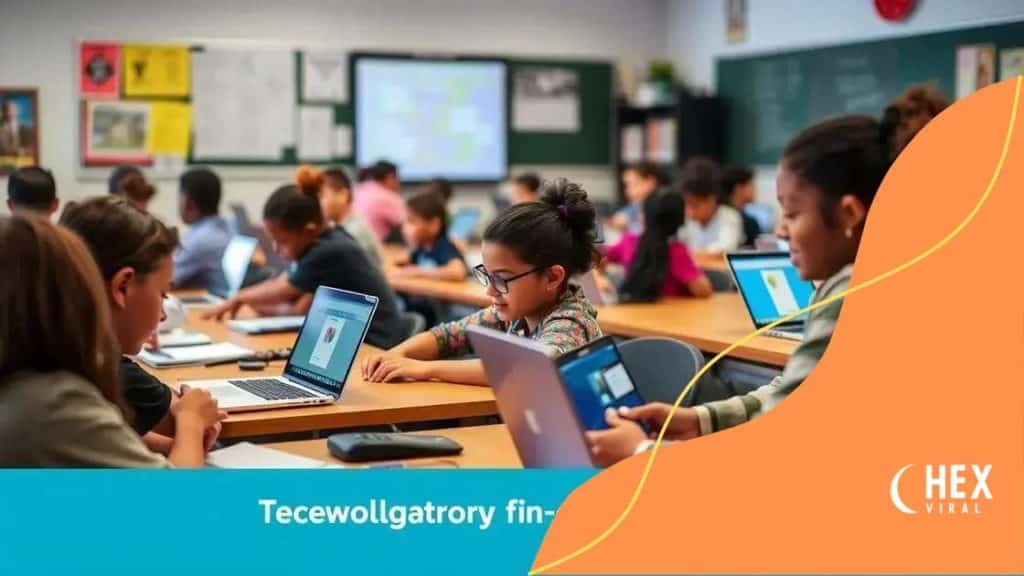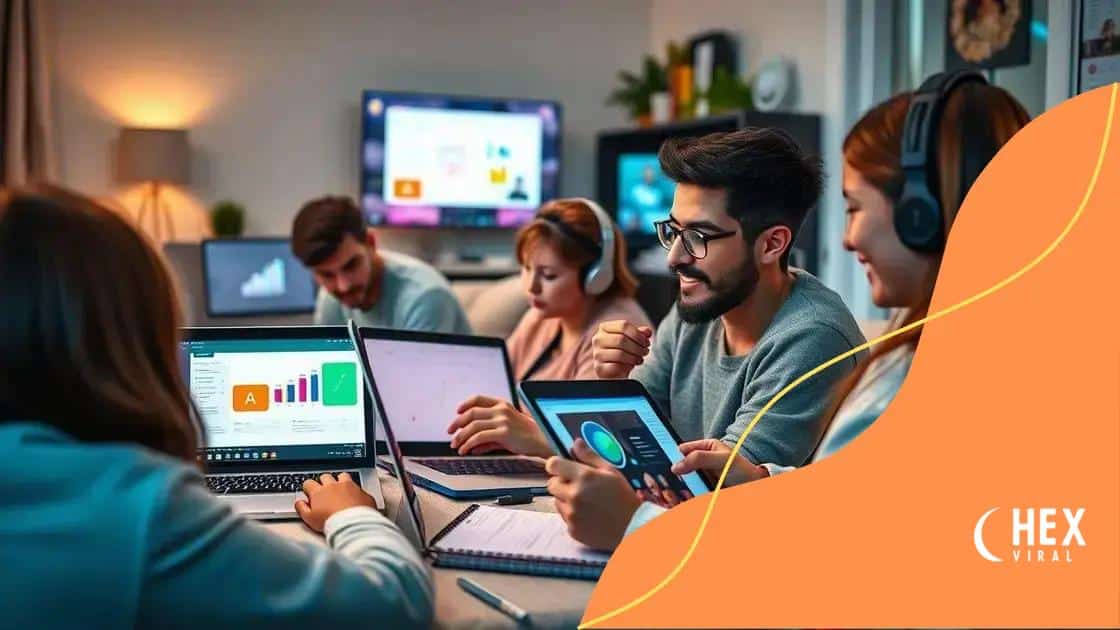Remote learning infrastructure investments transform education

Investing in remote learning infrastructure enhances educational access, engagement, and personalized learning, while addressing challenges like technical barriers, student motivation, and the need for effective assessment methods.
Remote learning infrastructure investments are reshaping how we engage with education today. Imagine a world where students have unparalleled access to learning resources from anywhere. This article dives into the intricacies of how these investments enhance educational experiences.
Understanding remote learning infrastructure
Understanding remote learning infrastructure is crucial for enhancing education today. This infrastructure encompasses the technological tools and systems that facilitate effective online learning experiences. With the rise of digital learning environments, schools and universities are tasked with developing robust infrastructure to support virtual learning.
Components of Remote Learning Infrastructure
A comprehensive remote learning system includes various elements that work together to create an engaging and effective educational environment. Key components include:
- Learning Management Systems (LMS) that organize and deliver course content.
- Reliable Internet Access ensuring that all students can connect without interruptions.
- Digital Communication Tools for interaction among students and instructors.
- Multimedia Resources like videos and interactive materials to enhance learning.
Each of these components plays a significant role in creating a successful remote learning environment. For example, an effective LMS not only delivers content but also tracks student progress, making it easier for instructors to provide support.
The Importance of Digital Tools
Investing in digital tools is vital for the adaptability of educational institutions. These tools help facilitate collaboration and engagement among students. Schools can enhance lessons with video conferencing, enabling face-to-face interaction even from a distance. Additionally, forums and chat platforms foster community and peer support, essential for student motivation.
Ultimately, understanding the intricacies of remote learning infrastructure helps schools and educators make informed decisions. Proper investments lead to a more engaging, accessible, and effective learning experience, paving the way for future educational advancements.
Benefits of investing in learning technology
Investing in learning technology brings numerous advantages that enhance the educational experience for both students and educators. These investments lead to improved access, engagement, and personalization in learning.
Enhanced Access to Resources
One key benefit is the increased access to educational resources. With online platforms, students can explore a vast array of materials anytime, anywhere. This flexibility allows learners to take charge of their education. Imagine being able to access expert lectures or specialized courses from the comfort of your home.
- 24/7 Availability: Learning resources are available round the clock.
- Diverse Content: A wide variety of subjects and materials for different learning styles.
- Global Collaboration: Students can work with peers from around the world.
Such accessibility not only empowers students but also encourages lifelong learning habits. When learners can engage with materials at their own pace, they are more likely to persist in their studies. This ongoing engagement fuels curiosity and motivation.
Increased Student Engagement
Investing in technology also boosts student engagement. Interactive tools make learning more enjoyable and effective. For example, virtual simulations and gamified learning experiences draw students in, making challenging subjects more approachable.
Moreover, technology enables personalized learning experiences. Educators can tailor lessons to meet individual students’ needs. When students engage with content that resonates with them, they retain information better and are more likely to participate actively in discussions.
As schools invest in learning technology, they aren’t just acquiring new tools; they are enhancing the entire educational experience, creating a vibrant and dynamic learning environment for all.
Key components of effective remote learning

When exploring effective remote learning, it’s essential to understand the key components that contribute to its success. These elements work together to create a seamless and enriching educational experience for students.
Reliable Technology
A strong foundation of reliable technology is critical. This includes hardware like laptops and tablets, as well as software that facilitates communication and learning. Access to technology enables students to connect with instructors and resources, regardless of location.
- High-speed Internet: A fast and stable connection is essential for streaming lessons and participating in interactive activities.
- Learning Management Systems: These systems organize course materials and track student progress efficiently.
- Support Systems: Technical support ensures that students can resolve issues quickly and continue their learning without disruption.
Investing in these technological components sets the stage for effective remote learning, helping to reduce barriers that students may encounter.
Engaging Course Content
Another key component is engaging and interactive course content. This includes multimedia resources that cater to different learning styles. Videos, quizzes, and interactive simulations can capture students’ interest and motivate them to participate actively.
Additionally, the integration of real-world applications into lessons strengthens understanding and relevance. By exploring how theoretical concepts apply in everyday life, students can see the value in what they are learning.
Effective Communication
Strong communication between educators and students is vital. Regular check-ins and feedback foster relationships and support. Instructors should create a welcoming virtual environment where students feel comfortable asking questions and seeking help.
Combining these key components—reliable technology, engaging content, and effective communication—forms the backbone of a successful remote learning experience. By addressing each aspect thoughtfully, schools can significantly enhance their educational offerings.
Challenges in implementing remote learning solutions
Implementing remote learning solutions can come with various challenges that schools and educators must navigate. Understanding these difficulties is key to finding effective strategies to overcome them.
Technical Barriers
One major challenge is technical barriers that affect both students and teachers. Many students may lack access to reliable devices or high-speed internet. This digital divide can prevent them from fully participating in remote learning.
- Device Accessibility: Not all students have laptops or tablets for online classes.
- Internet Connectivity: Poor internet speeds can disrupt learning and make it hard to engage in video calls.
- Technical Support: Some educators may not have the necessary training to effectively use new technologies.
Addressing these technical issues is vital for ensuring that all students can engage in remote education without interruption.
Student Engagement
Another significant challenge is maintaining student engagement during remote learning. The lack of face-to-face interaction can lead to feelings of isolation. Additionally, distractions at home can make it hard for students to focus during online classes.
In order to enhance engagement, educators need to create interactive and stimulating content. Using multimedia elements, group projects, and live discussions can help foster a sense of community among students.
Assessment and Monitoring
Assessing student performance can also be a challenge in remote learning environments. Traditional testing methods may not be suitable online. Educators must adapt assessment techniques to ensure they are fair and effective.
Utilizing online quizzes, project-based assessments, and portfolios can provide better insights into students’ understanding and abilities. This adaptation is crucial for tracking progress and offering meaningful feedback.
Successfully addressing these challenges requires a coordinated effort from educators, administrators, and families. By working together, stakeholders can create a more supportive and effective remote learning environment for all students.
Future trends in education technology investments
As we look ahead, understanding the future trends in education technology investments is vital for schools and educators. These trends will shape how learning occurs and what resources will become available.
Increased Use of Artificial Intelligence
One major trend is the increasing use of artificial intelligence (AI) in education. AI can personalize learning experiences by analyzing student data to tailor content to their needs. This allows for more effective learning pathways for students.
- Adaptive Learning Technologies: Programs that adjust the difficulty based on a student’s progress.
- Automated Assessments: AI can help grade tasks and quizzes faster.
- Chatbots for Support: Virtual assistants available 24/7 to answer student questions.
By leveraging AI, educators can provide individualized learning support, making education more effective for diverse learners.
Emphasis on Mental Health and Wellbeing
Another trend is the focus on mental health and wellbeing in the education space. As remote learning environments can contribute to feelings of isolation, schools are investing in technologies that support mental health.
These tools may include online counseling services and programs aimed at fostering social connections among students. Providing resources and support systems is essential for maintaining a healthy learning environment.
Expansion of Virtual Reality and Augmented Reality
The integration of virtual reality (VR) and augmented reality (AR) into the classroom is also on the rise. These technologies offer immersive experiences that can enhance engagement and understanding in subjects like science and history.
For instance, students can take virtual field trips or conduct experiments in a safe, simulated environment. This hands-on approach not only makes learning more exciting but also helps students retain information better.
Collectively, these trends indicate a dynamic and evolving educational landscape. As institutions invest in the latest technologies, the goal is to create inclusive, engaging, and effective learning experiences for all students.
remote learning infrastructure is essential for a brighter educational future. By embracing technology, schools can provide accessible and engaging learning experiences. The key components include reliable tech, engaging content, and strong communication. As we look forward, trends like AI, mental health support, and VR will continue to shape education. Together, we can overcome challenges and create opportunities for all learners to thrive.
FAQ – Frequently Asked Questions about Remote Learning Infrastructure Investments
What are the key benefits of investing in remote learning technology?
Investing in remote learning technology enhances access, engagement, and personalization, leading to better educational outcomes for students.
What challenges do schools face when implementing remote learning?
Schools often struggle with technical barriers, student engagement, and adapting assessment methods for online learning environments.
How can artificial intelligence improve remote learning?
AI can personalize learning experiences, automate assessments, and provide support through chatbots, making education more tailored and efficient.
What future trends should we expect in education technology?
Future trends include an increased focus on mental health, the integration of virtual and augmented reality, and advancements in AI technologies.






